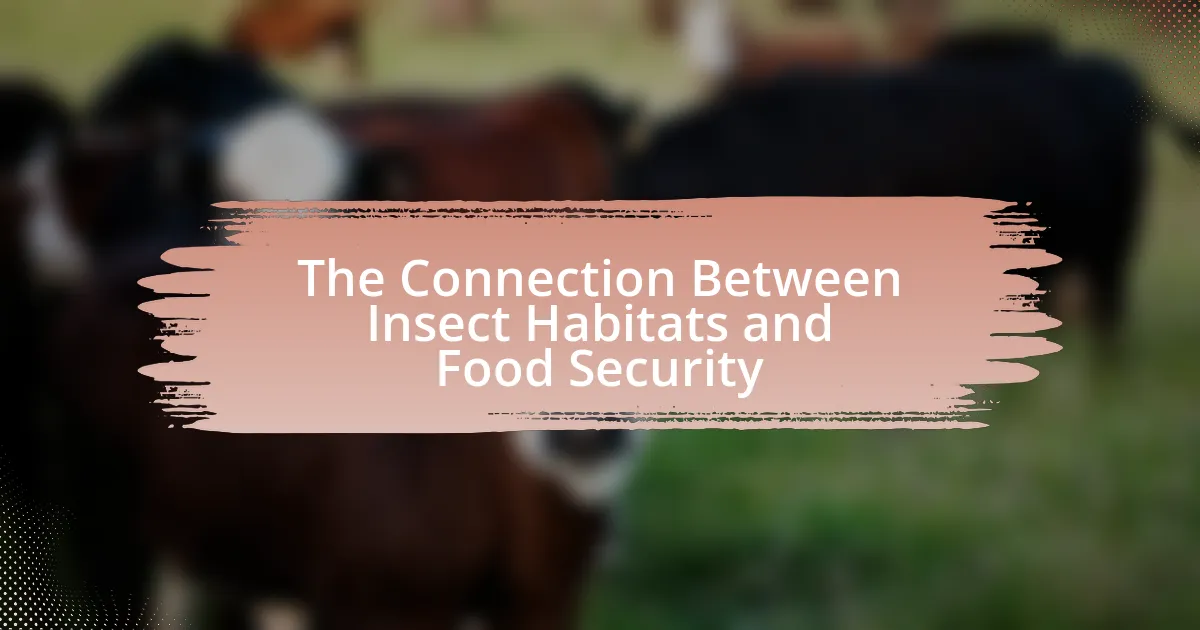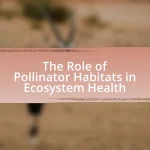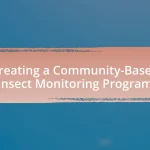The article examines the critical connection between insect habitats and food security, highlighting the essential roles insects play in pollination, pest control, and nutrient cycling. It discusses how healthy insect populations contribute to agricultural productivity, with approximately 75% of global food crops relying on animal pollination, primarily by insects. The article also addresses the challenges faced by insect habitats, including habitat loss, climate change, and pesticide use, which threaten food security. Furthermore, it outlines sustainable agricultural practices and policy changes that can enhance insect habitats, ultimately supporting biodiversity and improving food systems.
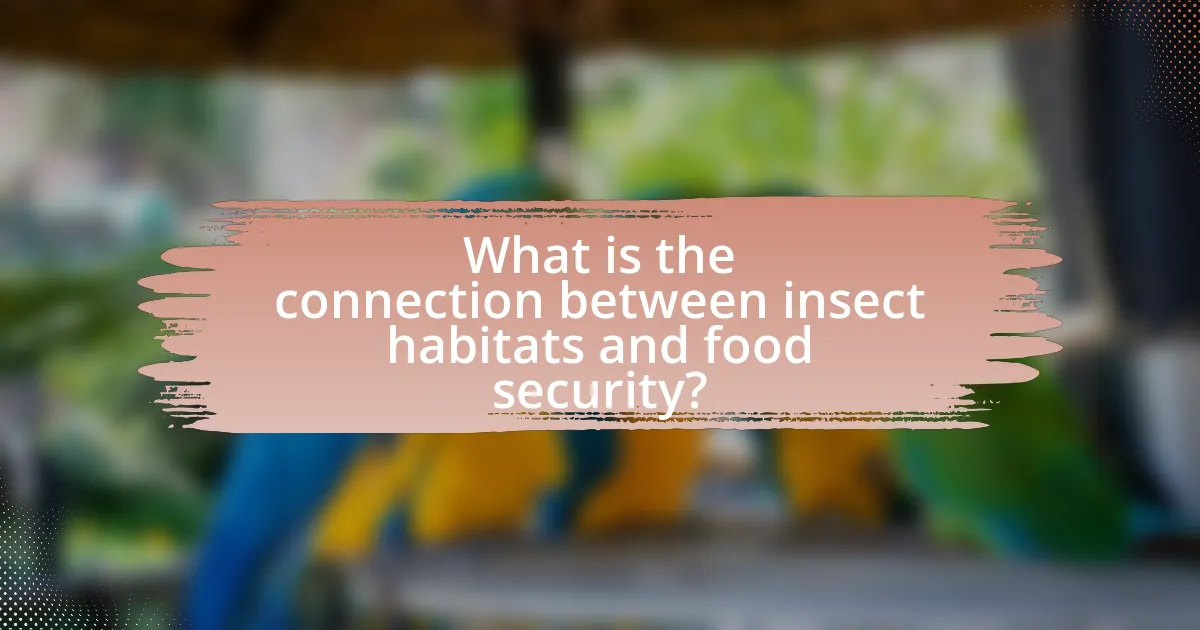
What is the connection between insect habitats and food security?
Insect habitats are crucial for food security as they support pollination, pest control, and nutrient cycling. Healthy insect populations contribute to the productivity of crops; for instance, approximately 75% of global food crops depend on animal pollination, primarily by insects. Furthermore, diverse insect habitats enhance ecosystem resilience, which is vital for maintaining agricultural yields in the face of climate change. Research indicates that the decline of insect populations can lead to reduced crop yields and increased reliance on chemical pesticides, ultimately threatening food security.
How do insect habitats influence agricultural productivity?
Insect habitats significantly influence agricultural productivity by supporting pollination and pest control. Healthy insect populations, which thrive in diverse habitats, enhance crop yields through effective pollination; for instance, studies show that crops like almonds and blueberries can yield up to 50% more when pollinated by insects. Additionally, insect habitats promote natural pest predators, reducing the need for chemical pesticides. Research indicates that farms with diverse insect habitats can experience up to a 30% decrease in pest-related crop damage. Thus, maintaining insect habitats is crucial for sustainable agricultural practices and food security.
What role do insects play in pollination and crop yield?
Insects are crucial for pollination, significantly enhancing crop yield. Approximately 75% of the world’s flowering plants and about 35% of global food crops depend on animal pollinators, primarily insects such as bees, butterflies, and beetles. Research indicates that crops like almonds, apples, and blueberries experience increased yields when insect pollinators are present, with studies showing that bee pollination can increase fruit set by up to 50%. This relationship underscores the vital role insects play in maintaining food security through their contributions to agricultural productivity.
How do insect populations affect soil health and fertility?
Insect populations significantly enhance soil health and fertility through their roles in decomposition, nutrient cycling, and soil aeration. For instance, decomposer insects like beetles and ants break down organic matter, which enriches the soil with essential nutrients. Research indicates that the presence of diverse insect species can increase soil organic matter by up to 30%, thereby improving soil structure and fertility. Additionally, insects such as earthworms, which are often classified as soil fauna, aerate the soil, facilitating water infiltration and root growth. This aeration process is crucial for maintaining healthy soil ecosystems, as it promotes microbial activity that further contributes to nutrient availability. Thus, the presence of robust insect populations is vital for sustaining soil health and enhancing agricultural productivity.
Why are insect habitats critical for sustainable food systems?
Insect habitats are critical for sustainable food systems because they support biodiversity, enhance pollination, and contribute to nutrient cycling. Biodiversity within insect habitats ensures the presence of various species that can perform essential ecological functions, such as pollination, which is vital for the production of many crops. For instance, studies show that approximately 75% of global food crops depend on animal pollination, primarily by insects. Additionally, insects play a key role in decomposing organic matter, which enriches soil health and fertility, thereby promoting sustainable agricultural practices. The presence of diverse insect populations in habitats directly correlates with increased agricultural productivity and resilience, making them indispensable for food security.
What are the ecological benefits of maintaining insect habitats?
Maintaining insect habitats provides critical ecological benefits, including enhanced pollination, improved soil health, and increased biodiversity. Pollinators, such as bees and butterflies, are essential for the reproduction of many flowering plants, contributing to approximately 75% of global food crops. Healthy insect populations also facilitate nutrient cycling and organic matter decomposition, which are vital for soil fertility. Furthermore, diverse insect habitats support a wide range of species, promoting ecosystem resilience and stability. Studies indicate that ecosystems with rich insect diversity are better equipped to withstand environmental changes, thereby supporting food security and agricultural productivity.
How do insect habitats contribute to biodiversity in farming?
Insect habitats significantly enhance biodiversity in farming by providing essential ecosystems that support various species. These habitats, such as hedgerows, wildflower strips, and cover crops, create niches for beneficial insects, including pollinators and natural pest predators. Research indicates that farms with diverse insect habitats can increase crop yields by up to 20% due to improved pollination and pest control. Furthermore, a study published in the journal “Agriculture, Ecosystems & Environment” by Kremen et al. (2007) found that farms with higher insect diversity experienced greater resilience against pests and diseases, thereby promoting sustainable agricultural practices.
What challenges do insect habitats face in relation to food security?
Insect habitats face significant challenges that directly impact food security, primarily due to habitat loss, climate change, and pesticide use. Habitat loss, driven by urbanization and agricultural expansion, reduces the availability of resources that insects need for survival and reproduction, which in turn affects their populations and the ecosystem services they provide, such as pollination. Climate change alters temperature and precipitation patterns, disrupting insect life cycles and leading to mismatches between insects and their food sources. Additionally, the widespread use of pesticides not only targets harmful species but also adversely affects beneficial insects, further diminishing their roles in food production systems. These factors collectively threaten the stability of food systems reliant on insect-mediated services, highlighting the critical link between healthy insect habitats and food security.
How does habitat destruction impact insect populations?
Habitat destruction significantly reduces insect populations by eliminating their natural environments and food sources. This loss of habitat leads to decreased biodiversity, as many insect species rely on specific plants and ecosystems for survival. For instance, studies have shown that agricultural expansion and urban development can result in a decline of insect species by up to 75% in affected areas, disrupting ecological balance and food webs. Furthermore, habitat fragmentation isolates insect populations, making it difficult for them to reproduce and thrive, ultimately threatening their survival and the services they provide, such as pollination, which is crucial for food security.
What are the effects of climate change on insect habitats and food security?
Climate change significantly alters insect habitats and threatens food security. Rising temperatures and changing precipitation patterns disrupt ecosystems, leading to habitat loss for many insect species. For instance, studies show that temperature increases can shift the geographical ranges of insects, affecting their populations and the pollination services they provide, which are crucial for food crops. Additionally, climate change can exacerbate pest outbreaks, as warmer conditions may favor the proliferation of harmful insects, leading to reduced crop yields. According to the Intergovernmental Panel on Climate Change (IPCC), these disruptions can result in a decline in agricultural productivity, thereby threatening food security for millions globally.
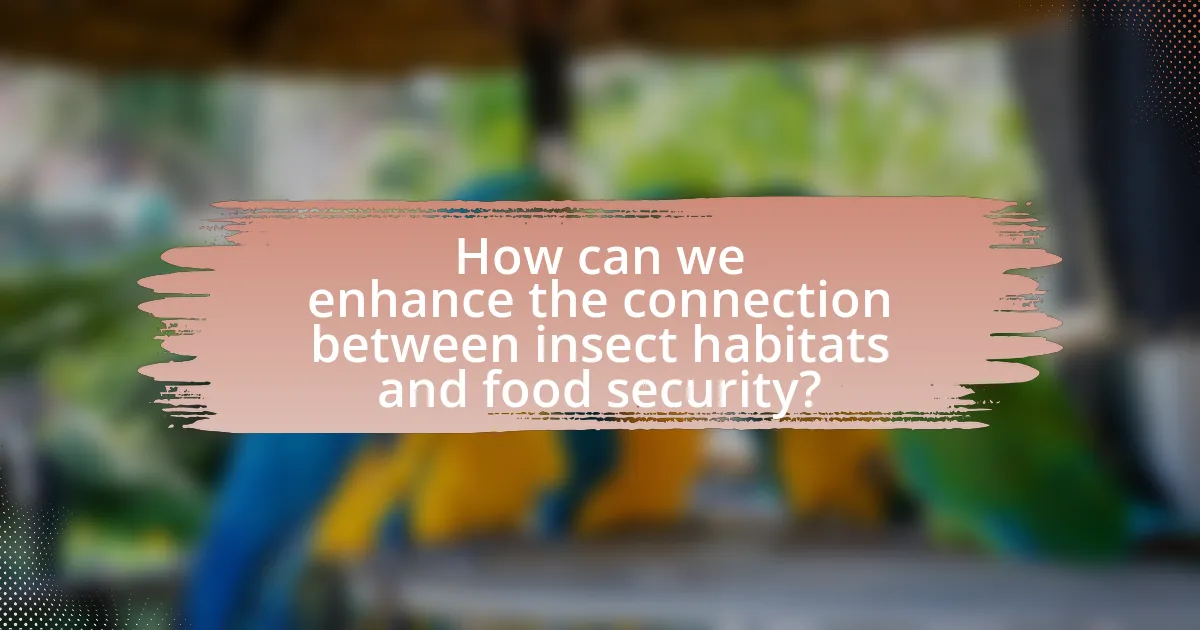
How can we enhance the connection between insect habitats and food security?
Enhancing the connection between insect habitats and food security can be achieved by promoting sustainable agricultural practices that support biodiversity. Sustainable practices, such as crop rotation, reduced pesticide use, and the establishment of insect-friendly habitats, can increase insect populations that are vital for pollination and pest control. Research indicates that diverse insect populations contribute significantly to crop yields; for instance, a study published in “Nature” by Garibaldi et al. (2013) found that pollinators increase agricultural production by up to 24%. By integrating insect habitats into agricultural landscapes, farmers can improve ecosystem services, thereby enhancing food security.
What practices can farmers adopt to support insect habitats?
Farmers can adopt practices such as planting cover crops, creating hedgerows, and reducing pesticide use to support insect habitats. Cover crops provide food and shelter for beneficial insects, while hedgerows offer a diverse habitat that attracts pollinators and predatory insects. Reducing pesticide use minimizes harm to non-target insect populations, promoting a balanced ecosystem. Research indicates that farms with diverse plantings and reduced chemical inputs can enhance insect biodiversity, which is crucial for pollination and pest control, ultimately contributing to food security.
How can integrated pest management benefit insect populations?
Integrated pest management (IPM) can benefit insect populations by promoting biodiversity and reducing reliance on chemical pesticides. IPM employs a combination of biological control, habitat manipulation, and cultural practices to manage pest populations sustainably. This approach encourages the presence of beneficial insects, such as pollinators and natural predators, which can enhance ecosystem health and resilience. Research indicates that farms utilizing IPM practices can support higher insect diversity compared to conventional farming methods, thereby contributing to the stability of food webs and improving food security.
What role do cover crops play in supporting beneficial insects?
Cover crops play a crucial role in supporting beneficial insects by providing habitat, food sources, and enhancing biodiversity. These crops, such as clover and vetch, attract pollinators and predatory insects, which help control pest populations. Research indicates that fields with cover crops can increase the abundance and diversity of beneficial insect species, leading to improved pest management and crop yields. For example, a study published in the journal “Agriculture, Ecosystems & Environment” found that cover crops significantly increased the presence of natural enemies of pests, thereby contributing to sustainable agricultural practices and food security.
How can policy changes improve insect habitat conservation?
Policy changes can improve insect habitat conservation by implementing regulations that protect natural ecosystems and promote biodiversity. For instance, establishing protected areas and enforcing land-use policies can prevent habitat destruction caused by urbanization and agriculture. Research indicates that regions with strong conservation policies, such as the European Union’s Natura 2000 network, have seen increased insect populations and diversity, which are crucial for pollination and pest control. Additionally, policies that incentivize sustainable farming practices can enhance habitat quality, thereby supporting insect populations essential for food security.
What regulations can promote sustainable agricultural practices?
Regulations that can promote sustainable agricultural practices include the implementation of integrated pest management (IPM) guidelines, conservation tillage requirements, and organic farming standards. IPM guidelines encourage the use of biological pest control methods, reducing reliance on chemical pesticides, which can harm insect habitats essential for pollination and ecosystem balance. Conservation tillage regulations minimize soil disturbance, enhancing soil health and promoting biodiversity, which is crucial for food security. Organic farming standards restrict synthetic fertilizers and pesticides, fostering a more sustainable approach that supports insect populations vital for crop production. These regulations collectively contribute to maintaining healthy ecosystems that are foundational for sustainable agriculture and food security.
How can community initiatives support insect habitat preservation?
Community initiatives can support insect habitat preservation by creating and maintaining local green spaces, such as community gardens and parks, which provide essential habitats for various insect species. These initiatives often involve local residents in planting native flora, which is crucial for sustaining local insect populations, including pollinators like bees and butterflies. Research indicates that urban green spaces can enhance biodiversity; for instance, a study published in the journal “Ecological Applications” found that urban gardens significantly increase the abundance and diversity of pollinators. Additionally, community education programs can raise awareness about the importance of insects in ecosystems, promoting practices that protect their habitats.
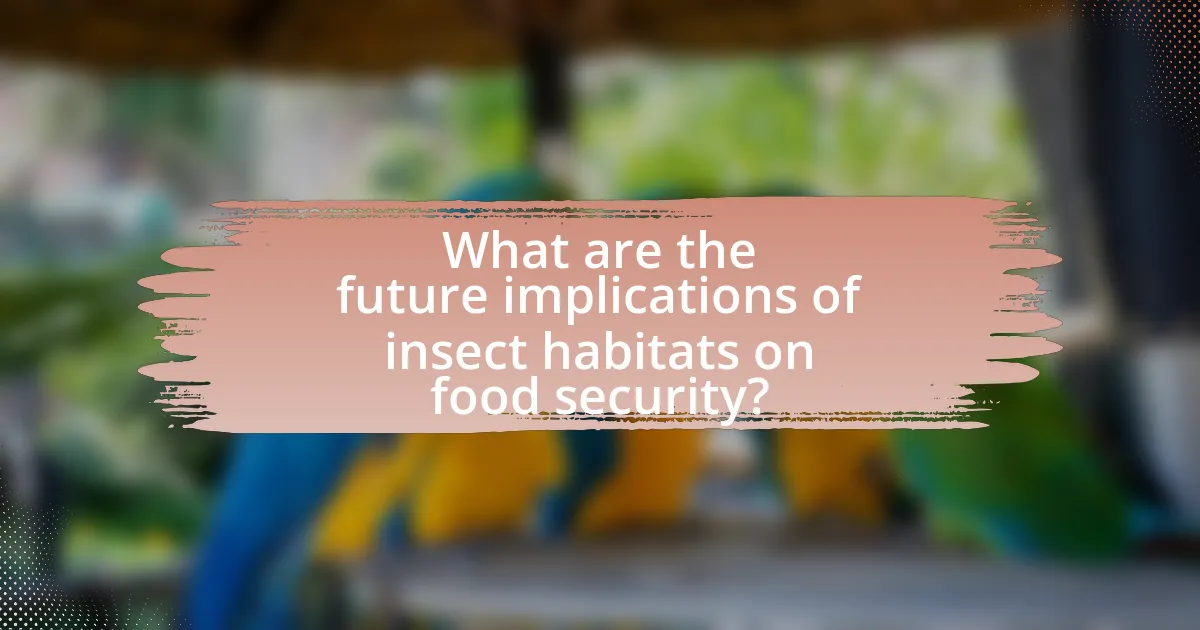
What are the future implications of insect habitats on food security?
Insect habitats will significantly influence food security by enhancing agricultural productivity and promoting sustainable food systems. As insect populations thrive in diverse habitats, they contribute to pollination, pest control, and nutrient cycling, which are essential for crop yields. For instance, studies indicate that pollinators, including bees and butterflies, are responsible for approximately 75% of global food crops, underscoring their critical role in food production. Furthermore, maintaining healthy insect habitats can mitigate the impacts of climate change on agriculture, as resilient ecosystems are better equipped to adapt to environmental shifts. Thus, the future of food security is closely tied to the preservation and enhancement of insect habitats, which support vital ecological services necessary for sustainable food production.
How might advancements in agricultural technology impact insect habitats?
Advancements in agricultural technology can significantly alter insect habitats by changing land use patterns and pesticide application methods. Precision agriculture, which utilizes data analytics and technology, often leads to increased monoculture practices, reducing biodiversity and the variety of habitats available for insects. For instance, the widespread use of genetically modified crops can lead to a decrease in native plant species, which are crucial for many insect populations. Additionally, the application of advanced pesticides, such as neonicotinoids, has been shown to negatively affect pollinator species, leading to habitat degradation. Research indicates that these changes can disrupt ecological balance, as seen in studies highlighting declines in insect populations linked to agricultural intensification.
What innovations can enhance the coexistence of agriculture and insect habitats?
Innovations that can enhance the coexistence of agriculture and insect habitats include the implementation of agroecological practices, such as intercropping and cover cropping. These practices promote biodiversity, which supports insect populations that are beneficial for pollination and pest control. Research indicates that farms utilizing intercropping can increase insect diversity by up to 50%, thereby improving ecosystem services essential for food production. Additionally, the use of integrated pest management (IPM) strategies reduces reliance on chemical pesticides, fostering healthier insect communities. Studies show that IPM can lead to a 30% increase in beneficial insect populations, which directly contributes to sustainable agricultural practices.
How can research contribute to understanding the insect-food security link?
Research can enhance understanding of the insect-food security link by providing empirical data on the nutritional value of edible insects and their role in sustainable food systems. Studies have shown that insects are rich in protein, vitamins, and minerals, making them a viable alternative to traditional livestock. For instance, a study published in the journal “Food Security” by van Huis et al. (2013) highlights that insects can contribute significantly to food security by offering a high-quality protein source with a lower environmental impact compared to conventional meat production. Additionally, research can identify the ecological roles of insects in agricultural systems, such as their contributions to pollination and pest control, which are crucial for crop yields. This multifaceted approach allows for a comprehensive understanding of how integrating insects into food systems can address food security challenges.
What practical steps can individuals take to support insect habitats for food security?
Individuals can support insect habitats for food security by creating diverse gardens that include native plants, which provide essential food and shelter for pollinators and beneficial insects. Research indicates that gardens with a variety of flowering plants can increase insect populations, which are crucial for pollination and pest control, thereby enhancing food production. Additionally, individuals can reduce pesticide use, as chemicals can harm beneficial insect populations; studies show that organic farming practices can lead to healthier ecosystems and improved crop yields. Furthermore, maintaining natural habitats, such as leaving areas of wildflowers or native grasses, supports insect biodiversity, which is vital for sustainable agriculture.
How can urban gardening initiatives promote insect-friendly environments?
Urban gardening initiatives can promote insect-friendly environments by creating diverse habitats that support various insect species. These gardens often incorporate native plants, which provide essential food sources and shelter for pollinators and beneficial insects. Research indicates that urban gardens with a variety of flowering plants can increase insect diversity and abundance, contributing to ecosystem health. For example, a study published in the journal “Urban Ecosystems” found that urban gardens with native flora attracted 50% more pollinators compared to those with non-native species. This biodiversity not only enhances pollination services critical for food production but also fosters resilience in urban ecosystems.
What are the best practices for creating insect habitats in home gardens?
To create effective insect habitats in home gardens, incorporate diverse plant species, provide shelter, and maintain a water source. Diverse plant species attract various insects, including pollinators and beneficial predators, which enhance biodiversity and support food security. For instance, planting native flowers can increase local insect populations, as they are adapted to the local ecosystem. Providing shelter, such as brush piles or insect hotels, offers safe spaces for insects to reproduce and thrive. Additionally, maintaining a water source, like a small pond or birdbath, ensures that insects have access to hydration, which is crucial for their survival and activity. These practices collectively foster a healthy ecosystem that supports food production and enhances garden resilience.
